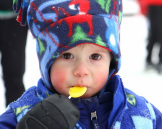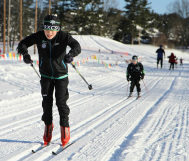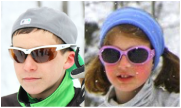Dress for success.The clothes don't make the skier, but the wrong clothes might unmake one - no one has fun when they're cold and wet. Clothing choice needs to be tailored to each kid’s activity level and personal thermostat, but here are some general tips from years of collective trial and error.
• Everyone should start with a base layer of non-cotton long underwear (top and bottom) for all but the warmest days. 
• The youngest skiers need to stay warm! (and still able to move a bit). They don't generate much extra heat and spend more time lying on the snow, so need warm and reasonably water-resistant clothes. Snowpants and down jackets are fine, and a good hat and mittens are a must.

• Older and more active skiers need warmth without overheating and clothing that will not restrict movement. Multiple layers are much better than one heavy jacket or snowpants, so that outer layers can be shed after warming up and put back on if it gets cold. Avoid cotton, in favor of synthetics and fleece that stay warm when sweaty. An outer layer that blocks the wind is usually more important than more insulation.
Hat Don’t leave home without one - or more than one! The lycra RXCSF hats are lightweight and good for racing and not-so-cold days. Consider a warmer wool hat on cold days. For the coldest days, a balaclava under a hat is great - or get creative with a neckwarmer/buff. Headbands are OK for racing and warm weather, but don’t substitute for a hat when it’s cold.
Socks Non-cotton technical socks that are long enough to extend beyond the top of the ski boot (Smartwool or comparable are worth the $ for a couple pair). Heavy rag wool socks can be too bulky - feet will get cold if they’re too tight in the boot. Gloves Gloves designed for cross country skiing allow better control of the poles. Lobster Mitts (thumb and 2 “fingers”) add warmth without losing pole control, and are the go-to handwear for many kids. Bulky downhill ski gloves and mittens can be clumsy and get soaked with sweat. That said, cold fingers can trump everything and hand temperatures vary widely from person to person, so do what you gotta do. (If you use handwarmer packets, make sure they're not too hot.) Jacket A wind-blocking lightweight jacket designed for skiing (ie doesn't restrict the arms when reaching for a double pole) is a great outer layer in cold or very cold weather. The team jackets from Mt. Borah fit the bill, and the Swix jackets available through NYSSRA are a great deal. Pants Wind-proof pants to wear over long underwear and/or racing tights for practice and in cold weather. The ones by Swix or Craft are great, and nearly affordable through the NYSSRA deal. Inexpensive nylon wind pants are good too. Cotton sweat pants? You guessed it: not as good. Race suit Cross-country skiers are nothing if not unabashed when it comes to hanging around in full body lycra. To wit: “Nothing beats a lycra uniform for cross country skiing. It can be used in almost all weather conditions and made warmer by layering with long underwear and a vest. Lycra tights are probably the singular most important piece of clothing.” – Coach Bob. That said, wind-blocking pants and jacket are probably more practical for most non-racing situations, and work perfectly fine for most kids during a race. That said, kids love the race suits - so why not? Vest Fleece or synthetic vests warm the core and block wind, while leaving the arms free. A great option over the race suit, or as a training layer. 
Glasses Protect your eyes from blinding snow glare, harmful UV, and other skiers' pole tips. Some programs are starting to require these for sprints and other mass start races. Available in regular or Jackie O.
|

